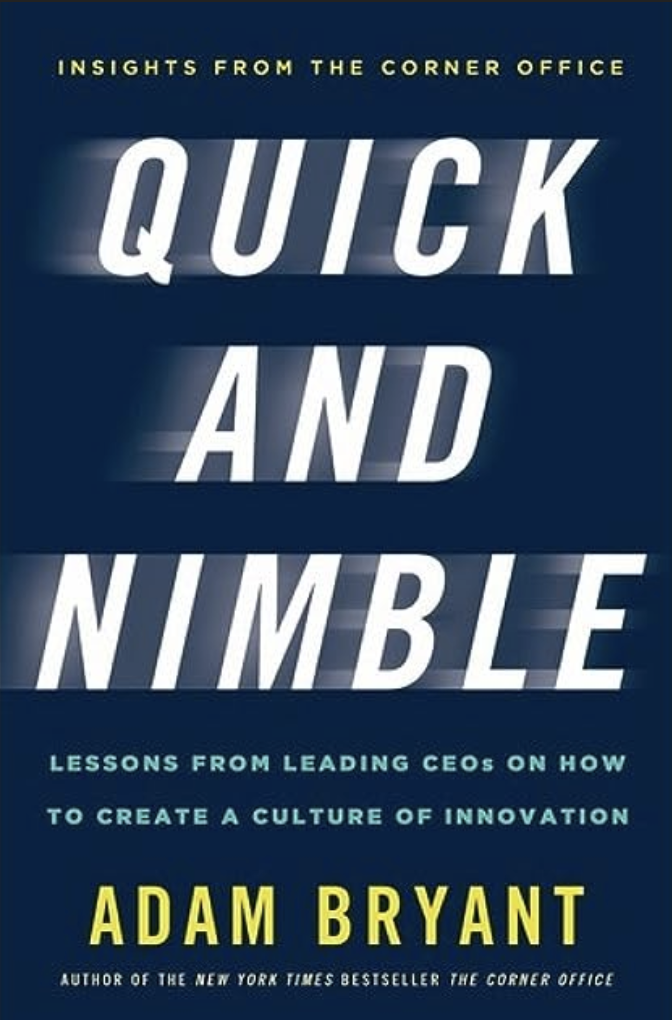Key Quote:
“Real innovation happens when all employees bring their best selves to work every day and freely share new ideas to help the team, knowing that they will be encouraged and rewarded to do so. The formula is simple but hard: innovation is the by-product of an effective culture” (p. 16). — Adam Bryant
Key Points and Concepts
Values are explicit manifestations of culture – codes of behavior, that everyone can agree on.
“The way we define culture overall is ‘how companies get things done.’ If you have a factory, you get a lot of things done through machinery. Most companies in software get things done through people. So our machinery is people, and to put it in technology terms, people are the hardware and our values are the operating system” – Mark Templeton, Citrix (p. 31).
“Two overarching rules about culture and values have emerged from my interviews with hundreds of CEOs: No. 1: There is no ‘right’ way to develop values. Values can come from the leaders themselves or they can be developed with input from everyone in the company (or a mix of both). What truly matters is … No. 2: The company has to live by its expressed values, reinforce them every day, and not tolerate behavior that is at odds with them” (p. 33).
To show you live up to your values, you have to make tough decisions about people. If you take action, for example, in a situation when a high performer somehow violates values, then the employees can feel that you’re putting your money where your mouth is.
The best way to do the opposite and therefore undermine a company’s values, is to have people in leadership positions that do not adhere to the values.
It’s About People
Tap into what’s meaningful for people. They don’t want to feel like they’re on a treadmill.
“It’s all about people, and so you’ve got to focus on that to understand what’s going on, what the context is and make sure you get people aligned around the right priorities. If you do that well, a lot can happen. If you don’t do that well, not much can happen” –Steve Case, Cofounder of AOL, CEO of Revolution (p. 13).
“What I think a great leader does, a great coach does, is understand what kind of talent you have and then you help people leverage that talent so that they can achieve what they never thought they were capable of…the only way you can do that is to care about the people who work for you. No one’s going to care about you unless you care about them. But if you care about someone, genuinely, then they’re going to care about you because you’re making a commitment and an investment in them” –David C. Novak, Yum Brands (p. 123).
Innovation
“Real innovation happens when all employees bring their best selves to work every day and freely share new ideas to help the team, knowing that they will be encouraged and rewarded to do so. The formula is simple but hard: innovation is the by-product of an effective culture” (p. 16).
“I learned very quickly that we did have an innovation problem, but we didn’t have an invention problem—and that’s an important distinction…So I very quickly started to tell people that we’re close. We have inventions. Most companies don’t have that. I describe innovation as invention with a customer at the other end. When it becomes a relationship that’s consummated with commercial transaction, then that’s an innovation. That adoption part of it was where we were not good. But the invention was there” – John Donovan, AT&T (p. 195).
Leadership
“I draw our organizational map upside down, because it’s not the leader and manager who do the work…the manager is there to give direction and make it possible for the others to do the job. And that’s clearly illustrated if you actually turn it on its head. Imagine showing a frontline employee the chart and saying ‘let’s find your box somewhere very, very far down here.’ Just the psychology of that is very depressing because those are the people who deal with customers in a lot of cases. And that’s a very important role” – Ivar Kroghrud, QuestBack (p. 58).
“The captain of the team doesn’t have to be the star. He can be the sixth man on the bench, but he has to be the one that excites people and gets them enthused about showing up every day” – Jarrod Moses, United Entertainment Group (p. 124).
“You can get a lot of speed by thinking of yourself as a chief ironing officer. Once you have a successful system in place, you can spend some of your time just walking around and talking to people and asking, ‘What’s preventing you from doing an even better job? What are you spending time on that you don’t feel you should be spending time on?’ Those kinds of questions are easy to ask and people relate to them” – Ivar Kroghrud, Questback (p. 133).
“When someone gives you an idea, try to wait just twenty-four seconds before criticizing it. If you can do that, wait twenty-four minutes. Then if you become a Zen master of optimism, you could wait a day, and spend that time thinking about why something actually might work” – Tony Tjan, Cue Ball (p. 220).
Bryant, A. (2014) Quick and Nimble: Lessons from Leading CEOs on how to Create a Culture of Innovation. New York: Henry Holt and Company, LLC.

“The way we define culture overall is ‘how companies get things done.’ If you have a factory, you get a lot of things done through machinery. Most companies in software get things done through people. So our machinery is people, and to put it in technology terms, people are the hardware and our values are the operating system” – Mark Templeton, Citrix (p. 31).
To show you live up to your values, you have to make tough decisions about people. If you take action, for example, in a situation when a high performer somehow violates values, then the employees can feel that you’re putting your money where your mouth is.
“When someone gives you an idea, try to wait just twenty-four seconds before criticizing it. If you can do that, wait twenty-four minutes. Then if you become a Zen master of optimism, you could wait a day, and spend that time thinking about why something actually might work” – Tony Tjan, Cue Ball (p. 220).
